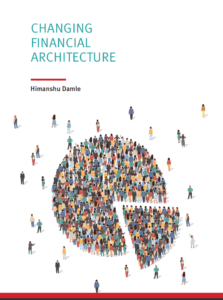Himanshu Damle
 Does configuration or reconfiguration of a nation’s financial system, which is comprised of financial institutions and markets, imply its growth and welfare? The question has a lot of gravity since it helps reconfiguring and/or re(formatting) reforms if the answer is in the affirmative. Such reforms help policy makers plug into the national economy and furthering its linkages on the global scale. The financial system primarily deals with transactions between surplus- and deficit-units. In an ideal situation, such a transaction takes place efficiently, but the reality is far from ideality. Yet, economic development is closely linked with financial architecture, in that the latter maneuvers the drivers of country’s economic development. In this era of globalization, the national economies are more or less tightly coupled to form a vast network of increasingly voluminous cross-border financial flows and growing integration of capital markets across borders. This is referred to as Financial Globalization, which in itself is an attributable subset of economic globalization that involves goods & services transcending national boundaries, while simultaneously catalyzing the reduction of policy barriers to such transactions. Financial Globalization, thus is a phenomenon that is susceptible to crests and troughs inexorably due to the strong coupling of national or regional economies. But, there are challenges, a disequilibrium between the global scale of Financial Globalization (as well as Economic Globalization) and national (or regional) scale of control and accountability. Even if there is a robust and healthy development on the national or regional scale, there is an absence of a global authority to enact such robustness or health to international scale. It is to fill this gap or normalize this disequilibrium that Financial Architecture is employed. In other words, Financial Architecture is devised to bring about a procedural order to international financial system.
Does configuration or reconfiguration of a nation’s financial system, which is comprised of financial institutions and markets, imply its growth and welfare? The question has a lot of gravity since it helps reconfiguring and/or re(formatting) reforms if the answer is in the affirmative. Such reforms help policy makers plug into the national economy and furthering its linkages on the global scale. The financial system primarily deals with transactions between surplus- and deficit-units. In an ideal situation, such a transaction takes place efficiently, but the reality is far from ideality. Yet, economic development is closely linked with financial architecture, in that the latter maneuvers the drivers of country’s economic development. In this era of globalization, the national economies are more or less tightly coupled to form a vast network of increasingly voluminous cross-border financial flows and growing integration of capital markets across borders. This is referred to as Financial Globalization, which in itself is an attributable subset of economic globalization that involves goods & services transcending national boundaries, while simultaneously catalyzing the reduction of policy barriers to such transactions. Financial Globalization, thus is a phenomenon that is susceptible to crests and troughs inexorably due to the strong coupling of national or regional economies. But, there are challenges, a disequilibrium between the global scale of Financial Globalization (as well as Economic Globalization) and national (or regional) scale of control and accountability. Even if there is a robust and healthy development on the national or regional scale, there is an absence of a global authority to enact such robustness or health to international scale. It is to fill this gap or normalize this disequilibrium that Financial Architecture is employed. In other words, Financial Architecture is devised to bring about a procedural order to international financial system.
Read and Download the booklet here: Changing Financial Architecture
Centre for Financial Accountability is now on Telegram. Click here to join our Telegram channel and stay tuned to the latest updates and insights on the economy and finance.

